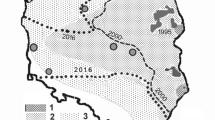Abstract
Dates of onset of canine babesiosis within a hyperendemic focus in France (Rhone Valley, south of Jura and north of the Alps) were compared to the seasonal population level of the adult stage ofDermacentor reticulatus over a 12-month period (December 1982–November 1983). Cases of babesiosis occurred in spring and fall when adultD. reticulatus were active. The fluctuations of the vector tick population and the onsets of canine babesiosis were also correlated with climatic changes: no tick activity or clinical cases of disease were detected in winter (low temperature) or in summer. The slight disparities observed between both distributions might be explained by various factors such as the development of immunity against the parasites, the intervals between tick bites and appearance of symptoms of the disease, or the asynchrony between different biotopes.
Similar content being viewed by others
References
Balashov, Y.S., 1972. Bloodsucking ticks (Ixodoidea)-Vectors of disease of man and animals. Misc. Publ. Entomol. Soc. Am., 8: 161–376.
Condoret, A., Baillenger, J. and Amiot, B., 1962. La piroplasmose canine dans le Sud-Ouest de la France. I. Epidémiologie. Ann. Parasitol. Hum. Comp., 37: 483–494.
Gilot, B. and Marjolet, M., 1982. Contribution à l'étude du parasitisme humain par les tiques. (Ixodidae et Argasidae) plus particulièrement dans le Sud-Est de la France. Med. Mal. Inf., 12: 340–351.
Gilot, B., Pautou, G. and Neuburger, M.C.F., 1974a. Les tiques du chien dans le Sud-Est de la France: notes sur la biologie et l'écologie deDermacentor reticulatus. (Fabricius 1794) (Ixodoidea; Ixodidae). Anim. Compagnie, 2: 109–114.
Gilot, B., Robin, Y., Pautou, G., Moncada, E. and Vigny, F., 1974b. Ecologie et rôle pathogène deDermacentor reticulatus (Fabricius, 1794) (Ixodoidea) dans le Sud-Est de la France. Acarologia, 16: 220–249.
Martinod, S., Gilot, B., Girel, J., Lachet, B. and Laurent, N., 1984. Cartographie épidémiologique à 1/50000 de la babésiose canine àBabesia canis dans le Bas. Bugey (Ain et Savoie). Doc. Car. Ecol., 28: 3–20.
Martinod, S., Brossard, M. and Moreau, Y., 1985. Immunity of dogs againstBabesia canis, its vector tickDermacentor reticulatus andIxodes ricinus in endemic area. J. Parasitol., 71: 269–273.
Meynard, J.A. and Goudichaud, J.A., 1974. Piroplasmose canine. Caractères Cliniques. Anim. Compagnie, 2: 147–155.
Razumova, I.V., 1965. Seasonal course of the diapause inDermacentor pictus Nerm. and stimuli factors. Med. Parazitol., 34: 46–52.
Robin, Y., 1974. Diagnostic de la piroplasmose canine par la recherche du piroplasma dans le sang. Technique et résults de quatre années d'observations. Anim. Compagnie, 2: 133–143.
Uilenberg, G., Franssen, F.F.J., Perié, N.M. and Spanjer, A.A.M., 1989. Three groups ofBabesia canis distinguished and a proposal for nomenclature. Vet. Q., II: 33–40.
Author information
Authors and Affiliations
Rights and permissions
About this article
Cite this article
Martinod, S., Gilot, B. Epidemiology of canine babesiosis in relation to the activity ofDermacentor reticulatus in southern Jura (France). Exp Appl Acarol 11, 215–222 (1991). https://doi.org/10.1007/BF01246093
Accepted:
Issue Date:
DOI: https://doi.org/10.1007/BF01246093




